Overview
- Brief Narrative
- Small, wooden bucket owned by a member of the Gaon family in Yugoslavia during the Holocaust. The Gaon family, Menachem (Mento), his wife Lottie and their son Izzica, lived in Sarajevo, Yugoslavia when Germany and its allies invaded and occupied Yugoslavia on April 6, 1941. Central Yugoslavia, including Sarajevo, was formed into the independent state of Croatia, ruled by the Ustasa. Soon after occupation, Mento and Lottie were arrested and sentenced to fifteen days hard labor. Later that year, the family escaped to the city of Split in the Italian-occupied zone where they would be safe. The Italian authorities treated Jews fairly, and rejected German demands to transfer Jews to German camps. In January 1942, the Italian authorities transferred the family from Split to Hvar Island. While there, Lottie arranged for her niece, Esther Mussafia, whose parents had been killed in concentration camps, to join them. From Hvar, they were transferred to Rab Island and interned in the Rab concentration camp. The Jewish section of Rab was equipped with food, schools, and a library. However, the Slovenian and Croatian section was kept in squalid condition and many prisoners died. In September 1943, after Italy surrendered to the Allies, the prisoners revolted and liberated themselves. Mento and Lottie then joined a partisan group and the family lived in the forests of the Velebit Mountain range, until the war’s end. In 1948, the Gaons immigrated to Israel.
- Date
-
acquired:
before 1941 April 06
- Geography
-
use:
Yugoslavia
- Credit Line
- United States Holocaust Memorial Museum Collection, Gift of Yaffa Gaon
- Contributor
-
Subject:
Menachem Gaon
- Biography
-
Menachem (Mento, 1904-?) and Lottie Gaon (nee Danon, 1908-?) lived in Sarajevo, Yugoslavia (now Bosnia and Herzegovina). Sarajevo had a Jewish population of approximately 10,500 before the war, making it the third largest Jewish center in Yugoslavia. Lottie and Mento were married in 1936 and had a son Izzica, (1938-1997). Lotties’s young niece, Esther Erna Mussafia (b. 1932) was in the wedding party. Mento was a civil servant who traded spices, wheat, and coffee for the government. Lottie was a housewife but occasionally helped her father, Moric, who owned a large textile store. The family were Sephardic Jews, descendants of Jews who were forced out of Spain or Portugal during the Spanish Inquisition. They regularly attended the Sephardic synagogue in Sarajevo, which was the largest in the Balkans. Mento and his brother, Baruch, sang in the choir group, which was called Fanfaro. Earlier in their lives the two of them travelled with the group and sang throughout Europe. The entire extended family was very active in the community, following the precedent established by their grandfather, Rafael. Antisemitism was uncommon in Yugoslavia, but after Hitler took power in Germany, it began to grow.
On April 6, 1941, Germany and Italy, supported by Hungary and Bulgaria, invaded Yugoslavia. The Germans took Sarajevo on April 15, and plundered and desecrated the Sephardic synagogue. Yugoslavia was partitioned, and central Yugoslavia, including Sarajevo, was formed into the independent State of Croatia, which was governed by the Ustaše and administered by the Germans. The regime enacted anti-Jewish laws, confiscated property and money, ordered Jews to register themselves, and forced male Jews to work hard labor. Most of the Gaon’s extended family members were taken to the camps, where nearly all of them perished. In April, Mento and Lottie were arrested and forced to do fifteen days hard labor. In November, Lottie and Mento hired a man to smuggle Lottie and Izzica to the Dalmatian Coast. The coast was occupied by the Italians, and the Jews there were treated well and not persecuted as in the other Yugoslavian zones.
Jews were barred from using public transport, so Lottie and Izzica travelled on a horse and buggy to the train station, where they met the smuggler. Lottie and Izzica boarded the train with the smuggler, but they could not get travel passes, meaning they could have been arrested at any time. They took the train through Mostar, and Metković, and arrived in Split, in the Italian occupied zone on the Dalmatian Coast. Mento could not travel with them, but joined them in Split a short time later. In January 1942, the Italian authorities transferred all three of them along with several other Jewish refugees in Split to Hvar Island.
While on Hvar, Lottie arranged for her niece, Esther, to come and live with them on the island. Esther, her father, Elijahu (1905-1941?) and mother, Rebecca (1912-1942?) were unable to escape the Ustaše and were arrested in Sarajevo near the end of 1941. Elijahu was taken to Jasenovac concentration camp, where it is presumed he was killed. Esther and Rebecca were taken to Đakovo concentration camp. Rebecca was deported and killed in the spring of 1942, likely in Auschwitz. Esther was able to avoid deportation and stayed in Osijek until May, when she travelled to Hvar and joined her remaining family.
In October, 1942, Mento, Lottie and Izzica were transferred to the concentration camp on the island of Rab, and Esther joined them in May, 1943. The concentration camp at Rab held Slovenian and Croatian opponents of the Italian regime in overcrowded tents. The Slovenian and Croatian prisoners lived in abysmal conditions, they were malnourished and not equipped for the cold weather, which resulted in many deaths. However, the Jewish prisoners were treated well and lived in barracks in a separate section. They were allowed to form their own school with a small library and had a sizable kitchen. The Jewish prisoners were brought to Rab as a defensive measure against German efforts to pressure Italy to participate in the deportation and murder of their Jewish prisoners.
In September 1943, after Italy surrendered to the Allies, the prisoners in the Rab camp revolted and liberated themselves before the Germans could come and take control of the camp. They then formed a partisan group called the Rab Brigade which fought against the Germans and the Ustaše. Mento and Lottie joined the partisans and brought Izzica and Esther with them. They all remained with the partisans, and lived in the forests of the Velebit Mountain range in the regions of Lika and Kordun until Yugoslavian liberation in May 1945.
After the war, they returned to their old house in Sarjevo. Mento worked with the Yugoslav government and Izzica returned to school. In December, 1948, Mento, Lottie and Izzica immigrated to Israel aboard the Radnick. Esther immigrated to Israel on December 26, on the Kefalos. Mento, Lottie and Izzica settled in Tel Aviv. Izzica joined the Israeli Air Force, became a designer, and worked at the Israel Museum.
Physical Details
- Classification
-
Decorative Arts
- Category
-
Woodwork
- Object Type
-
Wooden novelties (lcsh)
- Genre/Form
- Novelty works.
- Physical Description
- Small, cylindrical shaped, brown, wooden bucket with three evenly spaced legs. The bottom of the bucket is flat and smooth with three long, wide, legs extending out at a slight angle from the bottom edge. The exterior of the bucket has a smooth surface with a repeating centered design of a carved square outline. The interior of each square has a large carved X and each inside edge has two inverted, recessed triangles. The centered design is flanked by a scalloped upper and lower border. A pair of incised lines circle the top, near the rim, and a single line circles the bottom, near the base. Two small rectangular tabs extend up from the rim, each with a small centered hole. The exterior is smooth and coated with a finish and the interior is unfinished.
- Dimensions
- overall: Height: 3.125 inches (7.938 cm) | Diameter: 2.125 inches (5.398 cm)
- Materials
- overall : wood
Rights & Restrictions
- Conditions on Access
- No restrictions on access
- Conditions on Use
- No restrictions on use
Keywords & Subjects
- Topical Term
- Concentration camps--Italy. Forced labor--Yugoslavia. Holocaust, Jewish (1939-1945)--Yugoslavia. Israel--Emigration and immigration. Jewish children in the Holocaust. Jews--Persecutions--Yugoslavia. Sephardim--Yugoslavia--History. Wooden novelties. World War, 1939-1945--Concentration camps--Liberation. World War, 1939-1945--Jewish resistance--Yugoslavia.
Administrative Notes
- Legal Status
- Permanent Collection
- Provenance
- The miniature bucket was donated to the United States Holocaust Memorial Museum in 2017 by Yaffa Gaon, the widow of Izzica Gaon.
- Record last modified:
- 2022-07-28 21:50:58
- This page:
- https://collections.ushmm.org/search/catalog/irn596761
Download & Licensing
In-Person Research
- By Appointment
- Request 21 Days in Advance of Visit
- Plan a Research Visit
- Request to See This Object
Contact Us
Also in Gaon family collection
The collection consists of photographs, folk objects, coffee pots, a bowl, a tray, a bottle and a pair of socks that relate to the experiences of Mencham, Lottie, and Izzica Gaon and Esther Mussafia before, during and after the Holocaust.
Date: 1919-1945
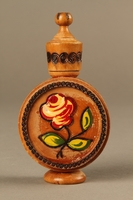
Wooden perfume bottle holder with recessed designs owned by a Yugoslavian family
Object
Wooden perfume bottle holder owned by a member of the Gaon family in Yugoslavia, during the Holocaust. The Gaon family, Menachem (Mento), his wife Lottie and their son Izzica, lived in Sarajevo, Yugoslavia when Germany and its allies invaded and occupied Yugoslavia on April 6, 1941. Central Yugoslavia, including Sarajevo, was formed into the independent state of Croatia, ruled by the Ustasa. Soon after occupation, Mento and Lottie were arrested and sentenced to 15 days hard labor. Later that year, the family escaped to the city of Split in the Italian-occupied zone where they would be safe. The Italian authorities treated Jews fairly, and rejected German demands to transfer Jews to German camps. In January 1942, the Italian authorities transferred the family from Split to Hvar Island. While there, Lottie arranged for her niece, Esther Mussafia, whose parents had been killed in concentration camps, to join them. From Hvar, they were transferred to Rab Island and interned in the Rab concentration camp. The Jewish section of Rab was equipped with food, schools, and a library. However, the Slovenian and Croatian section was kept in squalid condition and many prisoners died. In September 1943, after Italy surrendered to the Allies, the prisoners revolted and liberated themselves. Mento and Lottie then joined a partisan group and the family lived in the forests of the Velebit Mountain range, until the war’s end. In 1948, the Gaons immigrated to Israel.
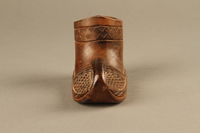
Small handmade wooden boot owned by a Yugoslavian family
Object
Small, wooden shoe owned by a member of the Gaon family in Yugoslavia during the Holocaust. The Gaon family, Menachem (Mento), his wife Lottie and their son Izzica, lived in Sarajevo, Yugoslavia when Germany and its allies invaded and occupied Yugoslavia on April 6, 1941. Central Yugoslavia, including Sarajevo, was formed into the independent state of Croatia, ruled by the Ustasa. Soon after occupation, Mento and Lottie were arrested and sentenced to fifteen days hard labor. Later that year, the family escaped to the city of Split in the Italian-occupied zone where they would be safe. The Italian authorities treated Jews fairly, and rejected German demands to transfer Jews to German camps. In January 1942, the Italian authorities transferred the family from Split to Hvar Island. While there, Lottie arranged for her niece, Esther Mussafia, whose parents had been killed in concentration camps, to join them. From Hvar, they were transferred to Rab Island and interned in the Rab concentration camp. The Jewish section of Rab was equipped with food, schools, and a library. However, the Slovenian and Croatian section was kept in squalid condition and many prisoners died. In September 1943, after Italy surrendered to the Allies, the prisoners revolted and liberated themselves. Mento and Lottie then joined a partisan group and the family lived in the forests of the Velebit Mountain range, until the war’s end. In 1948, the Gaons immigrated to Israel.
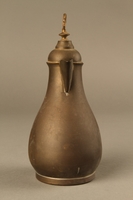
Small metal coffeepot used by a Yugoslavian family
Object
Small coffeepot owned by a member of the Gaon family in Yugoslavia during the Holocaust. The Gaon family, Menachem (Mento), his wife Lottie and their son Izzica, lived in Sarajevo, Yugoslavia when Germany and its allies invaded and occupied Yugoslavia on April 6, 1941. Central Yugoslavia, including Sarajevo, was formed into the independent state of Croatia, ruled by the Ustasa. Soon after occupation, Mento and Lottie were arrested and sentenced to fifteen days hard labor. Later that year, the family escaped to the city of Split in the Italian-occupied zone where they would be safe. The Italian authorities treated Jews fairly, and rejected German demands to transfer Jews to German camps. In January 1942, the Italian authorities transferred the family from Split to Hvar Island. While there, Lottie arranged for her niece, Esther Mussafia, whose parents had been killed in concentration camps, to join them. From Hvar, they were transferred to Rab Island and interned in the Rab concentration camp. The Jewish section of Rab was equipped with food, schools, and a library. However, the Slovenian and Croatian section was kept in squalid condition and many prisoners died. In September 1943, after Italy surrendered to the Allies, the prisoners revolted and liberated themselves. Mento and Lottie then joined a partisan group and the family lived in the forests of the Velebit Mountain range, until the war’s end. In 1948, the Gaons immigrated to Israel.
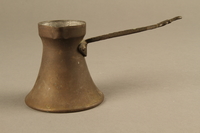
Turkish coffee finjan used by a Yugoslavian family
Object
Small finjan (also called a cevze) owned by a member of the Gaon family in Yugoslavia during the Holocaust. The Gaon family, Menachem (Mento), his wife Lottie and their son Izzica, lived in Sarajevo, Yugoslavia when Germany and its allies invaded and occupied Yugoslavia on April 6, 1941. Central Yugoslavia, including Sarajevo, was formed into the independent state of Croatia, ruled by the Ustasa. Soon after occupation, Mento and Lottie were arrested and sentenced to fifteen days hard labor. Later that year, the family escaped to the city of Split in the Italian-occupied zone where they would be safe. The Italian authorities treated Jews fairly, and rejected German demands to transfer Jews to German camps. In January 1942, the Italian authorities transferred the family from Split to Hvar Island. While there, Lottie arranged for her niece, Esther Mussafia, whose parents had been killed in concentration camps, to join them. From Hvar, they were transferred to Rab Island and interned in the Rab concentration camp. The Jewish section of Rab was equipped with food, schools, and a library. However, the Slovenian and Croatian section was kept in squalid condition and many prisoners died. In September 1943, after Italy surrendered to the Allies, the prisoners revolted and liberated themselves. Mento and Lottie then joined a partisan group and the family lived in the forests of the Velebit Mountain range, until the war’s end. In 1948, the Gaons immigrated to Israel.
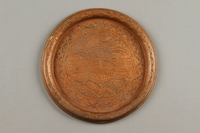
Small copper tray with a landscape scene owned by a Yugoslavian family
Object
Small tray owned by a member of the Gaon family in Yugoslavia during the Holocaust. The Gaon family, Menachem (Mento), his wife Lottie and their son Izzica, lived in Sarajevo, Yugoslavia when Germany and its allies invaded and occupied Yugoslavia on April 6, 1941. Central Yugoslavia, including Sarajevo, was formed into the independent state of Croatia, ruled by the Ustasa. Soon after occupation, Mento and Lottie were arrested and sentenced to fifteen days hard labor. Later that year, the family escaped to the city of Split in the Italian-occupied zone where they would be safe. The Italian authorities treated Jews fairly, and rejected German demands to transfer Jews to German camps. In January 1942, the Italian authorities transferred the family from Split to Hvar Island. While there, Lottie arranged for her niece, Esther Mussafia, whose parents had been killed in concentration camps, to join them. From Hvar, they were transferred to Rab Island and interned in the Rab concentration camp. The Jewish section of Rab was equipped with food, schools, and a library. However, the Slovenian and Croatian section was kept in squalid condition and many prisoners died. In September 1943, after Italy surrendered to the Allies, the prisoners revolted and liberated themselves. Mento and Lottie then joined a partisan group and the family lived in the forests of the Velebit Mountain range, until the war’s end. In 1948, the Gaons immigrated to Israel.
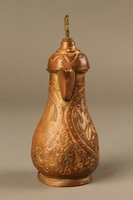
Small coffeepot and bowl with embossed designs used by a Yugoslavian family
Object
Coffeepot and bowl owned by a member of the Gaon family in Yugoslavia during the Holocaust. The Gaon family, Menachem (Mento), his wife Lottie and their son Izzica, lived in Sarajevo, Yugoslavia when Germany and its allies invaded and occupied Yugoslavia on April 6, 1941. Central Yugoslavia, including Sarajevo, was formed into the independent state of Croatia, ruled by the Ustasa. Soon after occupation, Mento and Lottie were arrested and sentenced to fifteen days hard labor. Later that year, the family escaped to the city of Split in the Italian-occupied zone where they would be safe. The Italian authorities treated Jews fairly, and rejected German demands to transfer Jews to German camps. In January 1942, the Italian authorities transferred the family from Split to Hvar Island. While there, Lottie arranged for her niece, Esther Mussafia, whose parents had been killed in concentration camps, to join them. From Hvar, they were transferred to Rab Island and interned in the Rab concentration camp. The Jewish section of Rab was equipped with food, schools, and a library. However, the Slovenian and Croatian section was kept in squalid condition and many prisoners died. In September 1943, after Italy surrendered to the Allies, the prisoners revolted and liberated themselves. Mento and Lottie then joined a partisan group and the family lived in the forests of the Velebit Mountain range, until the war’s end. In 1948, the Gaons immigrated to Israel.
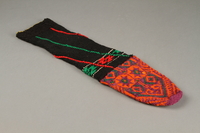
Pair of wool mid-calf socks worn by a Yugoslavian man
Object
Pair of socks owned by Menachem Gaon in Yugoslavia during the Holocaust. The Gaon family, Menachem (Mento), his wife Lottie and their son Izzica, lived in Sarajevo, Yugoslavia when Germany and its allies invaded and occupied Yugoslavia on April 6, 1941. Central Yugoslavia, including Sarajevo, was formed into the independent state of Croatia, ruled by the Ustasa. Soon after occupation, Mento and Lottie were arrested and sentenced to fifteen days hard labor. Later that year, the family escaped to the city of Split in the Italian-occupied zone where they would be safe. The Italian authorities treated Jews fairly, and rejected German demands to transfer Jews to German camps. In January 1942, the Italian authorities transferred the family from Split to Hvar Island. While there, Lottie arranged for her niece, Esther Mussafia, whose parents had been killed in concentration camps, to join them. From Hvar, they were transferred to Rab Island and interned in the Rab concentration camp. The Jewish section of Rab was equipped with food, schools, and a library. However, the Slovenian and Croatian section was kept in squalid condition and many prisoners died. In September 1943, after Italy surrendered to the Allies, the prisoners revolted and liberated themselves. Mento and Lottie then joined a partisan group and the family lived in the forests of the Velebit Mountain range, until the war’s end. In 1948, the Gaons immigrated to Israel.
Gaon family photographs
Document
Collection of pre-war and wartime photos belonging to Izzica Gaon (donor's late husband), from Yugoslavia.



